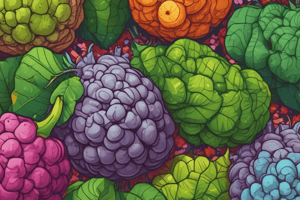Podcast
Questions and Answers
What is the primary characteristic of mono-cropping?
What is the primary characteristic of mono-cropping?
- Growing one crop consistently over several years (correct)
- Alternating crops seasonally
- Growing multiple crops in a year
- Growing legumes and oilseeds simultaneously
Which of the following is an advantage of mono-cropping?
Which of the following is an advantage of mono-cropping?
- Improved pest control
- Simplified sowing and harvesting with machinery (correct)
- Increased soil fertility
- Diversity in crop production
What defines parallel cropping?
What defines parallel cropping?
- Growing multiple crops at the same time throughout their life cycle (correct)
- Growing two crops in distinct rows
- Growing a crop following another crop in a different season
- Harvesting crops at separate times of the year
What is mixed cropping?
What is mixed cropping?
What is a disadvantage of multiple cropping?
What is a disadvantage of multiple cropping?
Which type of cropping allows a harvested crop to regenerate?
Which type of cropping allows a harvested crop to regenerate?
What does multi-storied cropping involve?
What does multi-storied cropping involve?
What defines sequential cropping?
What defines sequential cropping?
Why might a farmer choose mono-cropping?
Why might a farmer choose mono-cropping?
Which type of multiple cropping involves planting and harvesting crops in overlapping time periods?
Which type of multiple cropping involves planting and harvesting crops in overlapping time periods?
What is one advantage of mixed cropping?
What is one advantage of mixed cropping?
Which of the following is a disadvantage of intercropping?
Which of the following is a disadvantage of intercropping?
What defines row intercropping?
What defines row intercropping?
What is the main objective of intercropping?
What is the main objective of intercropping?
Which type of intercropping involves planting one crop after the first has reached its reproductive stage?
Which type of intercropping involves planting one crop after the first has reached its reproductive stage?
What is one of the drawbacks of mixed cropping?
What is one of the drawbacks of mixed cropping?
Which of the following is a benefit of intercropping?
Which of the following is a benefit of intercropping?
What is not a type of intercropping mentioned?
What is not a type of intercropping mentioned?
Which arrangement characterizes mixed intercropping?
Which arrangement characterizes mixed intercropping?
Which type of intercropping allows for independent cultivation while promoting interaction?
Which type of intercropping allows for independent cultivation while promoting interaction?
Flashcards are hidden until you start studying
Study Notes
Advantages and Disadvantages of Mixed Cropping
- Lowers risk of crop failure by diversifying planted crops.
- Meets daily food requirements for grains, oilseeds, pulses, and more.
- Enhances soil fertility when legumes are included as minor crops.
- Allows better distribution of labor throughout the planting and harvesting periods.
- Increases gross monetary returns from diverse crop outputs.
- Challenges include difficulty in controlling pests, diseases, and weeds.
- May negatively impact primary crop yields due to competition.
- Not feasible for mechanized harvesting.
Inter-cropping Overview
- Involves simultaneous cultivation of two or more crops on the same land.
- Focuses on maximizing productivity both spatially and temporally.
- Enhances productivity through efficient resource utilization.
- Example of inter-cropping includes Maize and Pigeon pea planted in a ratio of 2:1.
Advantages and Disadvantages of Intercropping
- Can improve soil fertility and overall agricultural productivity.
- Maintains higher crop yields compared to mono-cropping.
- Maximizes resource use efficiency.
- Helps prevent soil erosion and reduces pest and disease incidence.
- Enhances soil structure and water retention.
- Difficulties arise in mechanized harvesting and intercultural operations.
- Increased resource competition among crops can occur.
Types of Intercropping
Mixed Intercropping
- Crops are grown without specific row arrangements.
- Example: Sorghum, pearl millet, and cowpea broadcast together under rainfed conditions.
Row Intercropping
- Involves planting crops in distinct rows for simultaneous growth.
- Example ratios include Maize with green gram (1:1) or Groundnut with Red gram (6:1).
Relay Intercropping
- Second crop planted during the reproductive stage of the first crop.
- Ensures crop harvesting overlap; e.g., Rice followed by pulses in fallow.
Strip Intercropping
- Crops are grown in strips that allow for independent cultivation while supporting interaction.
- Example: Groundnut planted alongside red gram in a strip configuration.
Relay Cropping
- Sequential planting of a new crop while the preceding crop is still growing.
Types of Cropping System
Mono-Cropping
- Single crop grown continuously year after year.
- May be influenced by climate, socioeconomic factors, or farmer specialization.
- Example: Growing groundnut in arid regions or rice in irrigated areas.
Multiple Cropping
- Cultivating two or more crops on the same land within a year, enhancing intensity.
- Involves shorter planting and harvesting periods.
Types of Multiple Cropping
Parallel Cropping
- Crops are grown together for all or part of their growth cycle.
Mixed Cropping
- Multiple crops grown together without row arrangements.
- Example: Mixture of maize, green gram, and pigeon pea alongside oilseed crops like groundnut or mustard.
Multiple Sequential Cropping
- Involves planting crops at different times, ensuring crop turnover throughout the year.
Sequential Cropping
- Growing various crops in a sequence, categorized into double, triple, or quadruple cropping.
Ratoon Cropping
- Involves allowing a harvested crop to regenerate.
Multi-Storied Cropping
- Different height crops are cultivated on the same land.
Disadvantages of Cropping Systems
- Soil fertility and productivity can decline due to constant cropping.
- Potential deterioration of soil structure.
- Increased prevalence of pests, diseases, and weeds in the cropping environment.
Studying That Suits You
Use AI to generate personalized quizzes and flashcards to suit your learning preferences.





